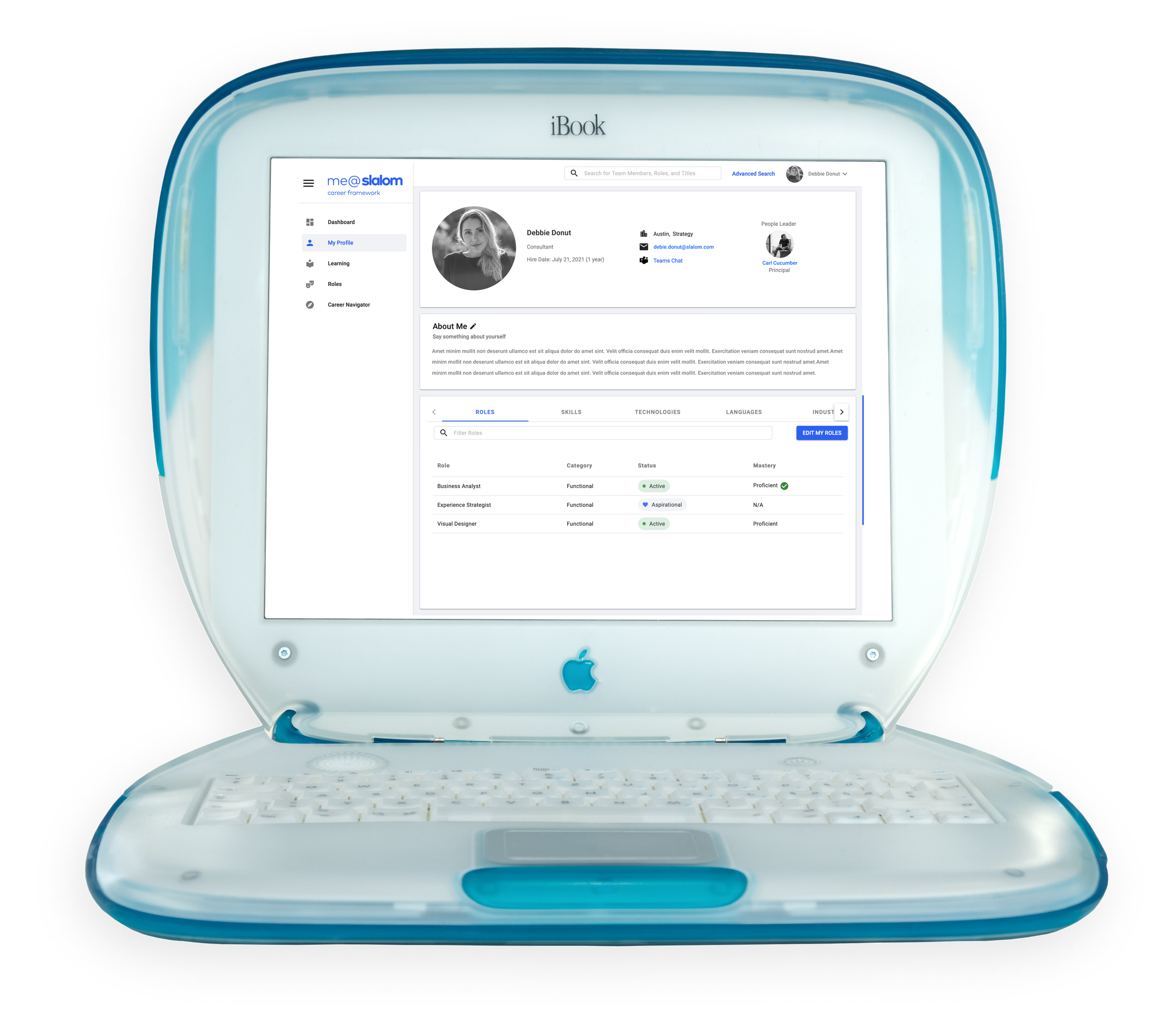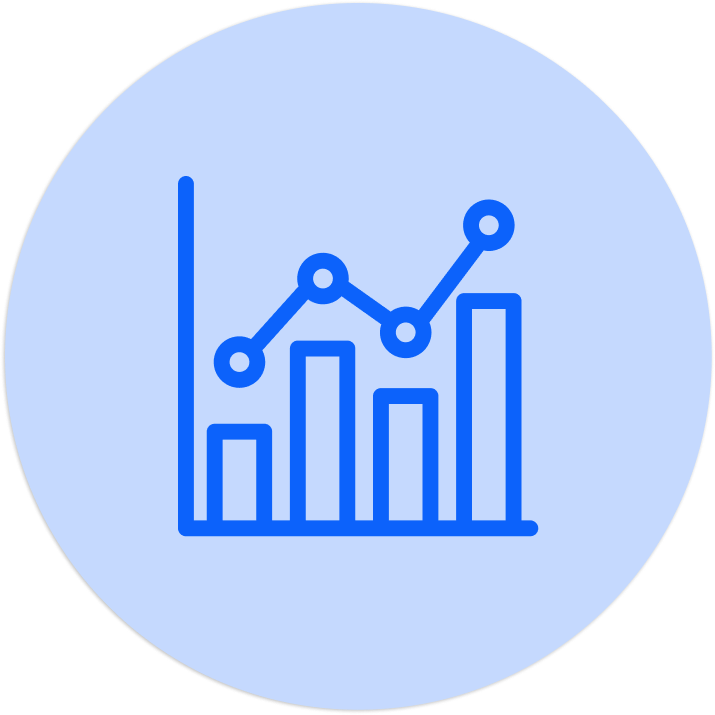Reimagining Employee Experience: Driving employee satisfaction through transparency in metrics and career growth
Designing and deploying a consolidated enterprise application for Slalom Consulting
Timeline:
February ‘23 - September ‘23
Role:
Responsible for research, concept development and visual design
Tools:
Figma, Miro, Adobe Illustrator, Adobe Photoshop, Material Design System, SparkThink, Jira
Mentors:
Product Owner, Lead UX Designer, 3 Experience Designers. Software Architect, 3 Front-end Developers
Challenge
Slalom is a global strategy consulting firm that heavily prioritizes a people-centric approach to talent management. Paradoxically, job-critical tasks and metrics were only accessible via disconnected and outdated enterprise platforms.
How might we consolidate and redesign disconnected enterprise platforms to improve the overall employee experience and reduce attrition rates?
Solution
Slalom Consulting requested UX research and a full redesign of the existing me@Slalom talent management platform to enable real-time transparency in business-critical employee metrics, client staffing opportunities, and career growth opportunities.
Redesign internal enterprise application to seamlessly integrate disconnected SaaS applications and related data.
Pilot B2B managed service to help existing clients consolidate disconnected HR applications to enhance visualization of employee metrics and talent resources.

My UX
process.

We conducted live user interviews of 30 people of differing title and tenure to understand their perspectives of the existing me@slalom site.
First 15 minutes were primarily contextual inquiry, involving observation of interviewees using the current platform
Second 15 minutes served as one-on-one discussions with users, giving insight into how interviewees respectively use the platform
Broader quantitative insights were gathered through a self-guided survey sent to 50 internal employees
pRIMARY RESEARCHUnderstanding the situation
Interview and survey insights were parsed and sorted into pain points and positive responses.
These groupings would become more granular with affinity mapping.
insight synthesisOrganizing interview insights by positives and pain points
Using Miro, unstructured interview insights were organized using the Affinity Diagram method, enabling me to pinpoint where common pain points lied with specific existing me@slalom features.
Larger insight themes consisted of the following:
Desire for real-time metrics
Generative AI opportunities and recommendations
Clarity in approval processes
Learning platform with recommendations
Simple client staffing portal
Defined career frameworks and pathways
affinity mappingThematically segmenting interview insights
Based on the interview and survey insights, user archetypes were identified based on interviewee demographics and responses.
Consultants, People Leaders, and Market Leaders were found to have both overlapping and distinct user needs from me@slalom.
ARCHETYPESWho we are designing for
INSIGHTS & findingsIdentifying areas of improvement
I found that users wanted the new me@slalom to reimagine six features centered around transparent performance management and career growth.
01. Actionable Metrics
Team members want utilization metrics displayed in real-time alongside improvement recommendations.
02. Talent Networks
Team members want the ability to search other company practitioners and network globally by employee capabilities.
03. Learning Opportunities
Team members want actually-useful learning and career growth content served to them
04. Workforce Management
Team members want to be recommended relevant client staffing opportunities
05. Team Performance Management
Team members want to not only see their own metrics but also holistic regional and global metrics
06. Career Growth Pathways
Team members want clearly outlined steps to achieve defined outcomes in their careers, without switching employers

Card sorting exercises guided the organization of the future-state information architecture
Iterative user feedback was solicited to further refine the proposed user flows within the redesigned me@slalom platform
user flow mappingMapping existing user flows to access features
I began by mapping out the existing me@slalom user flows which represent the disconnected processes to access job-critical features and metrics
user flow mappingExploring an optimized UX flow

DESIGN explorationDrafting wireframes
After finalizing the user flows, I explored multiple variations and ultimately integrated the most promising elements to create low-fidelity wireframes
design systemReducing tech debt risk with modular design
The existing me@slalom platform used a custom design system to guide UI design, a choice maintained in early wireframes and customized in later prototypes
Developer reviewIterating wireframes with developer feedback
Developer review sessions were conducted weekly with product owners and solution architects
Feedback served as a reminder of technical and financial development constraints, and guided my iterative design choices

DESIGN REFINEMENTDeveloping high-fidelity prototypes
After defining and validating the app structure in wireframes, I began incorporating visual elements consistent with user needs
Early draft wireframes guided the structure of the site
Iterative user feedback guided the movement of application features and components
Final prototypes fully integrated Slalom design system components to create an on-brand user experience
accessibility considerationsDesigning high-contrast and dark mode variations
Both a dark mode and high-contrast variation of the full site were developed to address user accessibility needs.
As new features were iteratively deployed, our team monitored bounce rates, pages-per-visit, click rates, and visit duration to quantitatively evaluate user experience.
With this data, we could adjust our designs to best align to user needs.
Feedback & RefinementGuiding refinement through quantitative behavioral metrics

final designDashboard
The new Dashboard offers micro-interactions aiming to improve transparency and actionability in business-critical utilization metrics.
final designMy Profile
My Profile acts as a global networking portal by organizing employee personal and professional details into granular, searchable sections.
final designMy Roles
My Roles offers employees a defined process to change roles and career trajectories without leaving Slalom.
Learning Catalogue consolidates previously separate internal learning sites, and gives AI-driven learning recommendations to employees.
final designLearning Catalogue
My Quick Actions leverages existing employee profile data and machine learning to suggest actionable metric improvement recommendations to consultants and managers.
final designMy Quick Actions
User feedback guided the decision to maintain the existing Staffing Opportunities advanced search feature, enabling users to have autonomy in search modality used.
final designStaffing Opportunities

With existing insight into our client’s tech stack, we hypothesized the business value in cross-selling a managed, B2B HRIS solution to existing IT change management clients.
Future considerationsIdentifying managed service opportunities
Through interviews with a sample of client CPOs and HR leadership, we identified a desire for a bespoke, managed HR service similar to me@slalom.
Driven by post-pandemic trends, Gartner estimated $195 Billion of spending across Financial Services and Retail industries on Cloud SaaS products in 2023.
Future considerationsIdentifying pilot opportunities
future considerationsIdentifying client managed service needs
Insights from client HR and IT leadership and IT highlighted six features present in the me@slalom platform that they desired in our pilot SaaS solution.
Workforce Management Systems
Performance management, employee development, and document control systems.
Time & Payroll Management Systems
Time, expense and payroll management systems to manage employee pay and financial documentation.
Applicant Tracking Systems
Internal and external applicant tracking and role/staffing workflows.
Learning Management Systems
Learning platform with ability to recommend and serve relevant content to employees.
Enterprise Resource Planning
Employee related data and enable integration and automation of critical business processes.
HR Generative AI
Manage, analyze, understand, and act in real-time on vast amounts of employee data.
Our existing UX process offered a repeatable, modular approach to understanding our client’s unique tech stack and developing bespoke managed services.
Slalom aims to pilot client-branded me@ services as a managed approach to consolidating and visualizing existing HR applications, employee data, and business processes.
Future considerationsBuilding a customized managed service






































